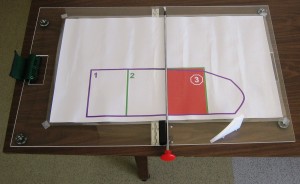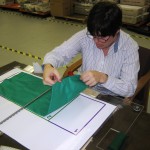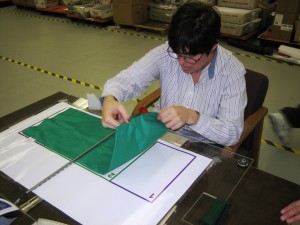Designers: Meghan Hegarty and Theresa Forshey
Client Coordinator: Cyeteese Garrett
INTRODUCTION:
Orange Enterprises is a community rehabilitation program that employs people with disabilities to perform a variety of jobs. One of their jobs is to fold and package pillowcases into a plastic sleeve. In general, the individuals selected for this job are not physically impaired, and thus the actual folding action does not present a challenge. Instead, the problem lies in remembering how to orient the pillowcase, the direction in which to fold it, and ensuring that the ends meet and that it is wrinkle-free. The goal of this project was to develop an aid that guides employees throughout the task and enforces proper technique, leading to increased productivity, improved quality, and greater independence.

Figure 1: The pillowcase folding aid, which includes the acrylic work surface, a center divide rode that provides a central axis for folding. One of the folding templates is shown on the work surface, which outlines the different steps for folding a particular pillowcase.
SUMMARY OF IMPACT:
According to the client coordinator, “The pillow case device will be used as a training device for clients as well as a guide for others that may need additional cues to complete all steps of task. At this time we have a limited number of clients who can fold the pillow cases appropriately. With the device, clients will show an increase in productivity. We are also confident that this device will enable more clients to perform the task of folding the different shapes of pillow cases.”
TECHNICAL DESCRIPTION:
The Pillowcase Folding Aid consists of an acrylic work surface and a center-divide rod (Figure 1). The work surface can easily be cleaned, and is hinged at the center for compact storage and simplified transportation. The center-divide rod provides a central axis for folding, and it permits both right- and left-handed operation. The rod is held in place by a magnetic that is mounted into the work surface, and the client can move the rod out of the way when necessary. A vertical side wall is also included to help guide the user in positioning the rod over the magnet in the central location.
We developed instructional templates that guide the user step-by-step through the folding process. They contain numbered outlines of a particular pillowcase at various stages of folding. To keep the process simple for our clients with cognitive limitations, there are no more than 5 numbered steps, and the outlines of the shapes are color-coded to assist with easy matching. Different templates were made for each type of pillowcase. The job coach must tape the appropriate template to the work surface before the client begins using it.
In order to fold the pillowcase, the client simply needs to match and align it with the appropriate outline on the instructional template. Then, they fold the pillowcase over the center-divide rod axis, which acts as an indicator of the folding direction and ensures that the pillowcase is folded completely in half (figure 2). This matching, aligning, folding sequence is repeated until the pillowcase fits completely within the last shape, which we designed to resemble a ‘Stop’ sign; the client was easily able to relate to this analogy.
The total cost of the device was approximately $78.




University Operator: (919) 962-2211 | © 2024 The University of North Carolina at Chapel Hill |